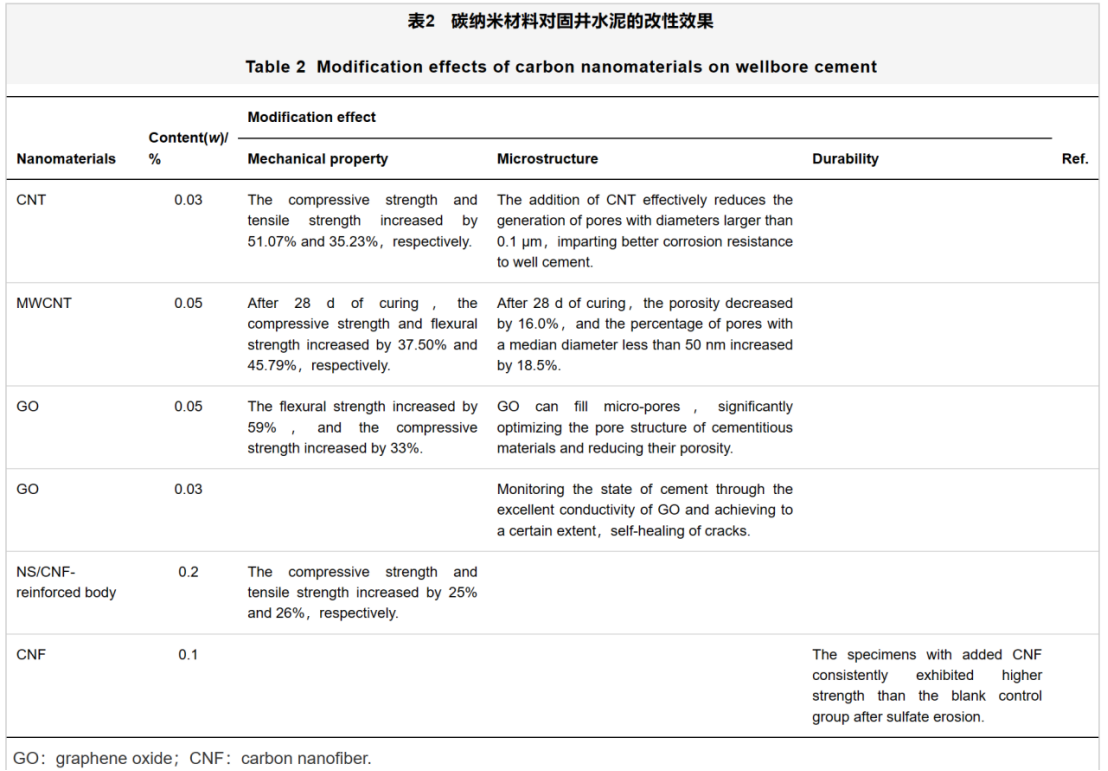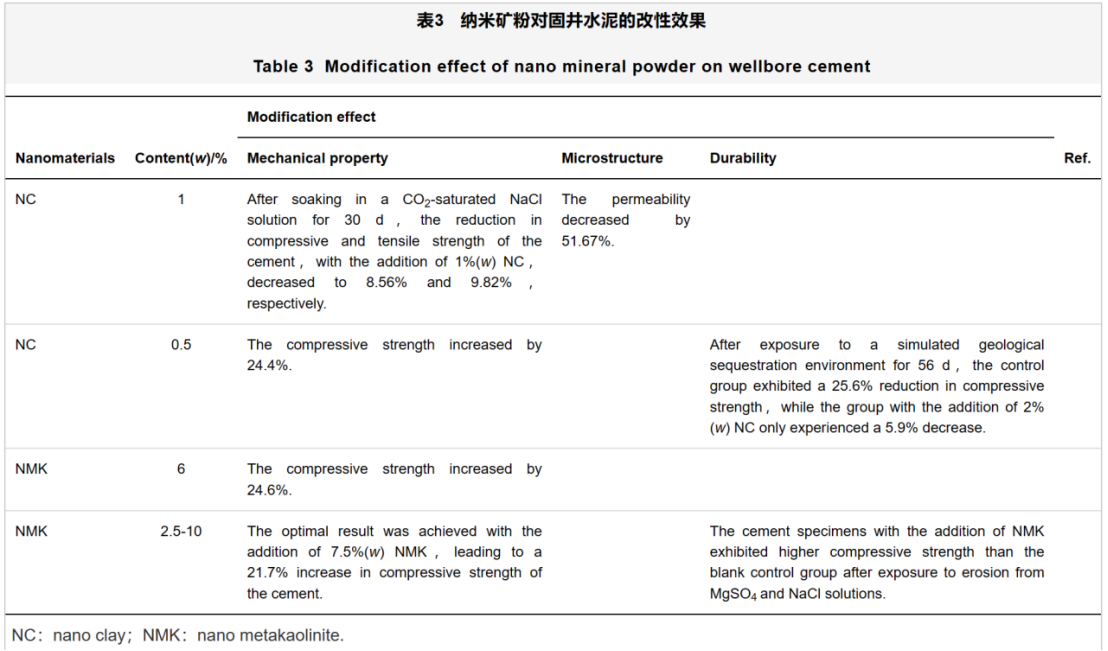Research and Application Progress of Nanomaterials in Wellbore Cement for Geological Carbon Dioxide Storage(Part 2)
2. Application of Nanomaterials in Wellbore Cement
2.1 Nanooxide Materials
The commonly used nano oxide materials in wellbore cement include NS, nano Al2O3 (NA), NT, etc.
2.1.1 NS
NS particles are one of the most commonly used nano additives in the petroleum industry, typically composed of ultrafine glass particles about one thousandth the size of cement materials. There are several possible mechanisms for NS in cement. Firstly, the nanoscale size of the particles enables them to serve as filling materials to fill the voids within the cement matrix, forming a dense microstructure and reducing capillary porosity. Secondly, NS particles have higher volcanic ash reactivity, allowing them to react with cement during the hydration process, generating additional C-S-H, enhancing the mechanical and durability properties of the cement system, reducing porosity and permeability, and effectively preventing the invasion of CO2 into cement slurry, enhancing its corrosion resistance.Dos Santos Batista et al. exposed the cement system to CO2 saturated solution under simulated storage conditions and found that after carbonation reaction, the distribution of calcium and silicon between the carbonated and unreacted areas of the cement system with NS was more uniform than that of the control group, proving that the addition of NS is beneficial for maintaining the durability of cement.
2.1.2 NA
As a volcanic ash material, NA has more active chemical properties than NS and acts as a filler in the gaps between cement particles, making the microstructure of cement denser. NA can accelerate the synthesis of hydration products, making the bonding between hydration products closer. At the same time, it can generate C-A-H or calcium aluminosilicate hydrate gel through the secondary hydration reaction, and the hydration products are stacked more closely, eventually forming a dense network structure, optimizing the strength of cement. On the other hand, the addition of NA can refine the pore size and form more C-S-H gel. Barbhuiya et al. studied the effect of NA on the early microstructure properties of cement slurry and found that the addition of NA can lead to an increase in the amount of monosulfide hydrated calcium aluminate, an increase in solid volume, and the formation of a denser microstructure, greatly slowing down the penetration and adsorption rate of chlorides and improving the corrosion resistance of cement.

2.1.3 NT
NT is a nanomaterial with excellent mechanical properties, electromagnetic wave shielding and absorption performance, antibacterial performance, strong redox performance, and acid alkali corrosion resistance. When combined with cement-based materials, it is expected to obtain a multifunctional water mud based material with excellent structural and functional/intelligent properties. NT, as a non reactive nanoparticle, can alter the microscopic particle size distribution, improve porosity, and provide additional nucleation sites for cement hydration products. The C-S-H hydrates around the nanoparticles are attracted to form small aggregates, resulting in finer particles and tighter structures. Adding NT can also shorten the curing time of cement slurry, and the higher the NT content, the shorter the curing time. This is because the rapid consumption of free water accelerates the bridging process of gaps, resulting in an increase in viscosity and a reduction in solidification time. The filler effect and the increase of C-S-H nucleation point promote the improvement of cement mechanical properties. However, further research is needed on the rheological behavior of NT under carbon capture and storage conditions and its resistance to CO2 erosion. Table 1 lists the modification effects of nano oxide materials on cement slurry.
2.2 Carbon Nanomaterials
Carbon nanomaterials mainly include CNT, graphene, graphene oxide (GO), CNF, and nano graphite sheets. The main materials used for wellbore cement modification are CNT, GO, and CNF.
2.2.1 CNT
CNT is a high-performance nanomaterial, divided into single-walled CNT and MWCNT. The addition of CNT has a significant impact on the microstructure and macroscopic properties of cement-based materials. On the one hand, CNT increases the amount of early hydration products and the proportion of high-density C-S-H gel through nano filling and nucleation, thus inhibiting the early autogenous shrinkage of materials, reducing the generation of early microcracks, and optimizing the porosity and pore size distribution of cement-based materials. On the other hand, CNT enhances the interface transition zone inside cement-based materials through bridging, effectively reducing the generation of microcracks. MWCNT can play a role in enhancing and toughening the mechanical properties of cement through network filling.
2.2.2 GO
GO is an important oxygen-containing derivative of graphene, which can be obtained by treating graphite with strong oxidants and acids. The microstructure of GO is usually a two-dimensional single-layer carbon atomic sheet, which has a high specific surface area and excellent mechanical, thermal and conductive properties. The introduction of oxygen-containing groups gives GO higher chemical stability. Liu et al. found that when the GO content was 0.03% (w), the permeability of the mortar increased by 80% and it was able to maintain high strength. This modified mortar can not only prevent damage to cement structures in harsh environments, but also save high maintenance costs, and has great application value. GO restricts the movement of CO2 towards the cementitious material through its barrier effect, slowing down the carbonization rate. During the CO2 storage process, CO2 and formation saline continuously erode cement, leading to the destruction of cement pore structure, the generation of cracks, and a decrease in storage efficiency. Therefore, researchers can also monitor the state of cement through the excellent conductivity of GO, and to some extent, self repair has been achieved.
2.2.3 CNF
CNF is structurally similar to CNT, but has a larger fiber length and aspect ratio. The main mechanism of CNF in cement-based materials is to become the attachment core of cement hydration products, promote the production of hydration products, and have filling and bridging effects. When CNF is fully uniform in cementitious materials, it can make the small pores inside the cement more dense and crosslink with each other to form a network grid structure in the cement, fixing the hydration products of the cement. At the same time, the bridging properties of fibers are supplemented to reduce the occurrence of cracks at the nanoscale and prevent the increase of crack width. Fehervari et al. found that the addition of 1% (w) CNF can significantly improve the mechanical properties of mortar, which is the result of the combined effects of bridging, pore refinement, and cement hydration. CNF also has good conductivity, which can transmit conductivity signals through the stress sensitivity of CNF/cement composite materials, sense possible stress changes in the well, and detect cement structure, thereby achieving long-term CO2 storage. Table 2 lists the modification effect of carbon nanomaterials on wellbore cement.

2.3 Nano Mineral Powder
The nano mineral powder used in wellbore cement mainly includes nano clay, nano metakaolin, nano zeolite powder, and halloysite nanotubes.
2.3.1 Nanoclay
The modification mechanism of nano clay as a volcanic ash material on cement is similar to that of NS particles. On the one hand, because it has a relatively small particle size, it can fill the micropores of the cement matrix and increase the density of solidified cement; On the other hand, during the hydration process, more C-S-H gel can be produced with free lime, effectively filling the capillary pores of the cement matrix, making the matrix have a dense microstructure, which can not only improve the strength of cement, but also prevent CO2 diffusion and minimize cement carbonization. Murtaza et al. found that adding 1% (w) of nanoclay can accelerate the strength improvement in the early stage, reduce permeability and porosity, and improve the compressive strength of cement. Unlike CO2 erosion in gas and solution states, supercritical CO2 has stronger permeability and fluidity. During the long-term invasion of supercritical CO2, nanoclay helps to improve the durability of wellbore cement.
2.3.2 Nanometer Metakaolin
At present, volcanic ash material has been proven to be a material with high strength, low porosity, high temperature resistance, and good chemical corrosion resistance in the early stages. The most common volcanic ash materials are fly ash, silica fume, and metakaolin, as fly ash is made by burning coal, its properties vary depending on the batch. The price of silicon powder is high, and it is not economical to use it for wellbore cement. The price of metakaolin obtained through kaolin heat treatment is much cheaper than that of silicon powder, and its properties are stable. Metakaolin mainly contains Al2O3 and SiO2, so it can reduce the silicon calcium ratio in cement and is of great significance for improving the mechanical strength of cement. Garg et al. analyzed the compressive strength of cement samples containing nano kaolin in the presence of MgSO4 solution and found that the cement samples containing nano kaolin had higher compressive strength at all stages, indicating that nano kaolin has good sulfate resistance. Similarly, placing the sample experiment in a NaCl solution and adding nano kaolin to the cement sample showed better mechanical properties at all ages, with less decrease in compressive strength. Moreover, the compressive strength of the sample in NaCl solution was higher than that in MgSO4 solution, indicating that nano kaolin has better resistance to Cl - corrosion. The above results indicate that nano kaolin improves the microstructure of cement through filling effect and volcanic ash reaction activity, thereby enhancing the durability of cement. Table 3 lists the modification effect of nano mineral powder on wellbore cement.

3. Conclusion
The failure of wellbore integrity is the main pathway for CO2 leakage, and the reduction of cement sealing capacity in the annulus has been proven to be one of the fundamental causes of wellbore integrity problems and CO2 leakage. Nanomaterials have great potential as additives for modifying well cementing cement. Based on their special physical effects such as surface effect and volcanic ash reactivity, nanomaterials can improve the hydration process and microstructure of cement-based materials at the nanoscale, enhance the mechanical properties of cement to varying degrees, reduce porosity and permeability, improve microstructure, and slow down CO2 erosion.
Nanomaterials have good application prospects, and in this process, the following points are particularly important: 1) The optimal content of nanomaterials added to cement needs to be determined based on the type and physicochemical properties of the nanomaterials. At present, there is no formula to describe the appropriate amount of nanoparticles added in wellbore cement that are beneficial for improving the properties of cement composite materials. 2) Optimizing the dispersion technology and scheme of nanomaterials in cement, and characterizing their in-situ dispersion state in cement products, is one of the challenges. Although ultrasonic treatment with or without dispersants can improve dispersibility, nanoparticles are still prone to agglomeration. 3) At present, many studies on the use of nanomaterials for CO2 geological storage are based on indoor experiments. In order to further develop the application of nanotechnology in geological storage, more on-site experimental work is needed.
